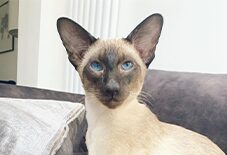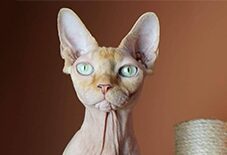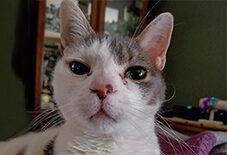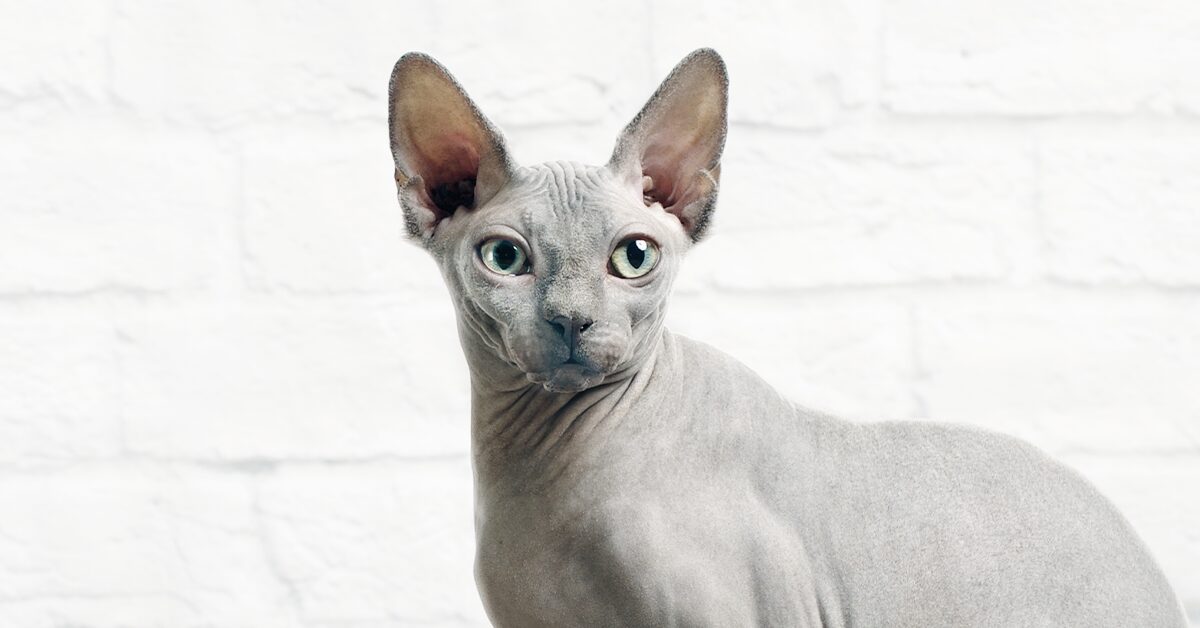
Meet the Sphynx
High Kitty I.Q.
Best Fur Friend
Uniquely Chic
If you’re looking for a quirky, fun-loving companion with a unique look and lots of love to give, I’m the breed for you! I know I don’t look like other cats, but my hairlessness is just one part of what makes me so special. Got kids and other pets? Good news – I’m super friendly and I get along with everybody! I’m also great for people with allergies. I just love to be with my humans, whether we’re snuggling or playing together.
I’m a high-energy athletic cat so I need lots of fun toys and a cat tree to climb on. I can amuse myself, but I’d much rather be playing with you – especially fetch! I’m extra sensitive to the sun though, so keep me indoors pawlease!
Some humans think my lack of fur means that grooming me is a breeze, but I actually need extra love in that department. Sans fur, my body oil will build up so I need weekly baths. I promise you’ll be rewarded with lots of affection and a funny little playmate to make you laugh. There’s a reason why I’m the 8th most popular cat breed!
Ready to learn more about me? Let’s dig in.
Ready to learn more about me? Let’s dig in.
 My Many Looks
My Many Looks
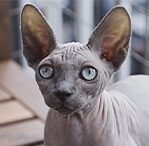
Blue
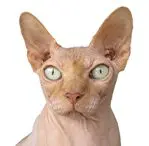
Cream
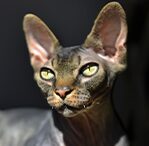
Tortoiseshell
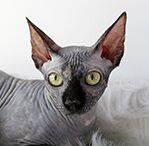
Seal Point
 My Breed Characteristics
My Breed Characteristics
 Furbulous Fact
Furbulous Fact
Because we Sphynx are so smart and trainable, we make purrfect animal actors! Perhaps the most iconic Sphynx of all time is Mr. Bigglesworth, Dr. Evil’s trusted companion from the Austin Powers movies. Mr. Bigglesworth, who was played by a champion purebred Sphynx named Ted Nude-Gent, is the parody version of the famous white Persian cat in the original James Bond movies. Of course, we Sphynx are much smarter and funnier than Persians, so it’s no surprise that they chose one of us as the fan-favorite feline in the parody movies. Yeah, baby!
 As I Grow Up
As I Grow Up
As you can see, we Sphynx age pretty gracefully. Here are a few key milestones in my growth & development to be aware of as I grow up from a kitten to an adult and senior!
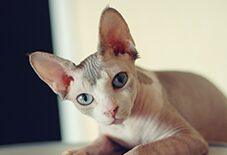
Kitten3-6 Months
I am going to need a lot of baths so get me used to a grooming routine early on. I’ll love the one-on-one time with you – and some treats won’t hurt either!
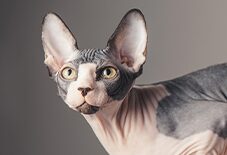
Adult1 Years
I’ve got sensitive skin so keep me out of the sun (and invest in cat sunscreen) and make sure I have some fun clothes or blankets when it gets cold.
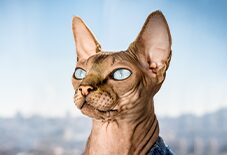
Senior9 Years
I’m prone to teeth & gum issues, so (along with routine vet check-ups) pawlease brush my teeth regularly!
 History of My Breed
History of My Breed
Even though we share a name (if not a spelling) with the ancient Egyptian Sphinx, we Sphynx cats are originally from Canada. We’re a pretty new breed, and while some might say we were an accident, we think we are a miracle of nature! In Toronto, Ontario, in 1966, a hairless kitten named Prune was born to Domestic Shorthair parents. Hairless cats occur naturally (although rarely) as a result of a genetic mutation, but my breed (originally called the Canadian Hairless) came about as a result of selective breeding. Prune was bred with his mother to produce another hairless kitten, and the earliest Sphynx cats were born!
There were a few bumps in the road for us, though. The Cat Fanciers’ Association originally recognized us in 1970, but they took it back because my ancestors who were related to Prune were having some health problems and the gene pool was not big enough. Luckily, another proto-Sphynx soon popped up on a farm in Minnesota. In 1975, a hairless kitten named Epidermis was born, and the year after that, another hairless kitten named Dermis came along. The humans who owned the farm, Milt and Ethelyn Pearson, sold these kittens to an Oregon breeder named Kim Mueske, who started a breeding program.
In addition to the Minnesota line, there is another line from Toronto essential to the development of our breed as it is today. In 1978, a Siamese cat breeder named Shirley Smith found three abandoned hairless kittens – Bambi, Punkie, and Paloma. Along with the Epidermis/Dermis Minnesota line, the Bambi/Punkie/Paloma Toronto line are the foundation of today’s Sphynx cats. Now a healthy and happy breed, we were officially recognized by the Cat Fanciers’ Association in 1998, and today we are the CFA’s 8th most popular breed!
 Pawesome Cats to Parent
Pawesome Cats to Parent
In addition to purebred Sphynx like me, there are tons of prrrfectly sweet mixed-breed Sphynx that are looking to find their furever homes. You can learn where to find your next pet below!
 Care Tips
from Dr. Gail Wolfe, Veterinarian
Care Tips
from Dr. Gail Wolfe, Veterinarian 
Protect your Sphynx’s skin.
Since Sphynx cats do not have fur, they must be protected from cold temperatures. It is suggested that they wear a sweater at all times. They are also at an increased risk for sunburn, so using cat sunscreen is advised when skin is exposed.
Bathe frequently with medicated shampoo.
Because of their lack of fur, Sphynx cats have extremely oily skin and must therefore be bathed frequently with warm (not hot) water using an anti-seborrheic type shampoo – once or twice weekly controls the grassiness and odor.
Feed your Sphynx according to special nutritional needs.
Sphynx cats have an exceedingly high metabolism and require a diet that is high in calories in order to maintain body heat. Feed them multiple small meals throughout the day using specially formulated food.

 Why Get Cat Insurance?
from Pumpkin®
Why Get Cat Insurance?
from Pumpkin®
While Sphynx are a generally healthy breed, cat-astrophes can happen to any cat at any age. If your kitty gets hurt or sick, pet insurance can help you say ‘yes’ to the best care, even when it’s costly. When it comes to shopping for this breed, you’ll want to choose insurance plans like Pumpkin's, which can help cover the costs associated with the hereditary conditions Sphynx are prone to developing. While a reputable breeder will conduct genetic testing on your kitty’s parents to help minimize the chances of passing down hereditary conditions, they can’t always be avoided. Let’s look at some common ones, and how Pumpkin Cat Insurance plans could help cover the cost of care!
 Heart Disease
Heart Disease
Sphynx are genetically predisposed to heart problems, specifically Hypertrophic Cardiomyopathy (HCM). In this condition, the muscle walls of the heart thicken causing a decline in cardiac function. While there is no cure, heart disease can be managed with medication and dietary changes.
- Cost to Treat
- $500-$3,000
- Pumpkin Pays Back*
- $450-$2,700
 Sunburn
Sunburn
Because the Sphynx does not have fur for protection from the sun’s rays, they are more likely to get sunburned. A moderate burn can be treated medicinally with steroids and antibiotics, but more severe burns may require hospitalization and skin grafts. Treatments prescribed by vets to treat sunburn are covered.
- Cost to Treat
- $200-$2,000
- Pumpkin Pays Back*
- $180-$1,800
 Periodontal Disease
Periodontal Disease
This breed is prone to periodontal (gum) disease, which occurs when plaque builds up and forms a layer of tartar that inflames the gums. Left untreated, gums weaken and separate from teeth. While routine brushing, cleanings, and antibiotic gels help treat milder cases, severe ones require surgery.
- Cost to Treat
- $400-$1,200
- Pumpkin Pays Back*
- $360-$1,080
 Ear Infection
Ear Infection
If their owners don’t give them regular cleanings, Sphynx are prone to ear infections (otitis). Most infections can be cleared up medicinally and/or with a full ear cleaning by your vet.
- Cost to Treat
- $200-$350
- Pumpkin Pays Back*
- $180-$315
*Example illustrates reimbursement of a covered vet bill at a 90% reimbursement rate, where the annual deductible had already been satisfied and the annual limit had not yet been met. Coverage and reimbursement results vary based on policy options.

